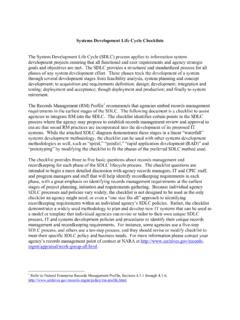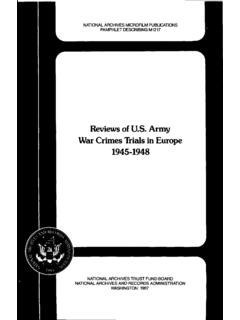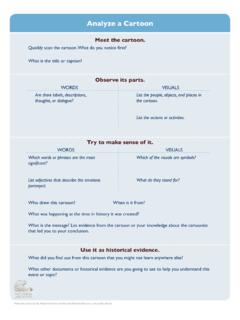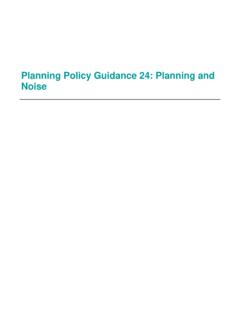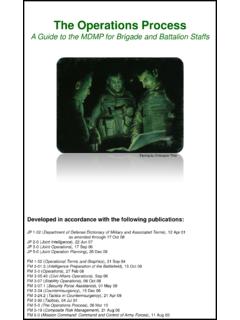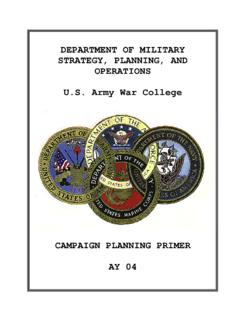Transcription of Guidance for Planning an Enterprise-wide …
1 1 National Archives and Records Administration E-Gov Electronic Records Management Initiative Recommended Practice: Developing and Implementing an Enterprise-wide Electronic Records Management (ERM) Proof of Concept Pilot March 2006 2 Recommended Practice: Developing and Implementing an Enterprise-wide Electronic Records Management (ERM) Proof of Concept Pilot A proof of concept pilot project is an opportunity to demonstrate the capabilities of Electronic Records Management (ERM) software on a small area and in a controlled manner. A pilot project is an excellent risk mitigation strategy for an agency Planning to implement a ERM system. It can also serve to inform or resolve an alternatives analysis for an agency during the investment Planning phase.
2 The pilot helps determine whether the software is appropriate for use by the agency and how easily it can be configured, providing hands-on experience for records managers, information technology (IT) personnel, and users. This document applies the principles and best practices of IT project management to a proof of concept demonstration pilot for ERM whose purpose is to assess whether the solution should be deployed agency- wide . Based on the experiences of ERM pilot projects at the state and federal level, this document can be used by agencies as a reference when they assemble pilot project teams, develop work plans, and solicit participants for an ERM pilot project. It is composed of six sections, followed by an Appendix of Resources for Conducting a Pilot Project: 1.
3 Introduction 2. Application of this Guidance Document 3. Planning the Successful Pilot Preliminary Activities Defining the Purpose, Goals, and Objectives of the Pilot Establishing Success Criteria Outlining the Benefits of a Pilot Project Defining the Scope and Duration Setting up Administrative Infrastructure and Writing the Work Plan Minimizing Risks Associated with Pilot Projects Conducting the Pilot Evaluating the Pilot 4. Key Outcomes 5. Lessons Learned 6. Summary Appendix: Resources for Conducting a Pilot Project 1. Introduction The strategic focus of the President s Management Agenda Electronic Government (E-Gov) initiatives is to transform federal programs and services into high-quality and well-managed cross-agency solutions to deliver services across the Federal government.
4 The National Archives and Records Administration (NARA) is the managing partner for the ERM E-Gov Initiative. The ERM Initiative provides a policy framework and Guidance for electronic records management applicable government- wide . The Initiative is intended to promote effective management and access to federal agency information in support of accelerated decision making. The project will provide federal agencies Guidance in managing their electronic records and enable agencies to transfer electronic records to NARA. 3 This Guidance document is one of a suite of documents to be produced under NARA s ERM Initiative that, when taken together, form the structural support for ensuring a level of uniform maturity in both the federal government s management of its electronic records and its ability to transfer electronic records to NARA.
5 This is the fifth of six documents to be produced under the Enterprise-wide ERM Issue Area, providing Guidance on developing agency-specific functional requirements for ERM systems to aid in the evaluation of Commercial Off-the-Shelf (COTS) products. The first document provides Guidance for Coordinating the Evaluation of Capital Planning and Investment Control (CPIC) Proposals for ERM Applications ( ). Electronic Records Management Guidance on Methodology for Determining Agency-unique Requirements ( ) offers a process for identifying potential ERM system requirements that are not included in the Design Criteria Standard for Electronic Records Management Applications, DOD ( ). Guidance for Evaluating Commercial Off-the-Shelf (COTS) Electronic Records Management (ERM) Applications ( ) summarizes the Environmental Protection Agency s (EPA) experience determining agency- wide Electronic Records and Document Management System (ERDMS) requirements and identifying the COTS products that would best meet the needs of agency staff for both Electronic Document Management (EDM) and Electronic Records Management (ERM) functionality.
6 Advisory Guidance for Building an Effective ERM Governance Structure ( ) defines governance and its importance to the success of IT, the purpose and function of that governance, how project-specific governance (such as those instituted for Enterprise-wide ERM) fits within and alongside other established governance structures, and the risks attendant in the absence of good governance. The final Guidance document in this series will be a lessons learned paper from EPA s proof of concept ERM pilot as well as other agencies implementation experience. The Guidance documents are aimed at helping federal agencies understand the technology and policy issues associated with procuring and deploying an Enterprise-wide ERM system. 2. Application of this Practical Guidance Document This practical Guidance presents lessons learned and experience gained in the development of proof of concept pilots for ERM.
7 It represents the experience of federal and state agency managers responsible for managing ERM pilot projects. As with other IT systems, agencies must adhere to OMB policies and Guidance when Planning for and selecting an ERM system. These policies are articulated in OMB Circular A-11 Part 7, Planning , Budgeting, Acquisition, and Management of Capital Assets1 and OMB Circular A-130, Management of Federal Information Additional OMB Guidance is found in OMB Memorandums (see ). The process described in the document provides insight into the steps necessary for making an ERM pilot project a success. The primary audiences for this document are those involved with the conduct of an ERM pilot project, including records managers, IT personnel, trainers, and selected end-user participants.
8 4 This document makes a number of assumptions as to the level of knowledge concerning ERM systems and about the capabilities an agency possesses to acquire and implement an ERM system, including that you already have: Created awareness as to the importance of records management to the efficient operation of the agency. Support of senior management for the ERM project as a whole, and the pilot project as a priority activity for the agency, is critical to successful implementation of an Enterprise-wide ERM system. Encouraged consistent record keeping behavior among staff through written policies, procedures, and records schedules that are up-to-date and include new programs and formats, providing training for new agency staff (and staff with new responsibilities).
9 An understanding of ERM (purpose, components, and functionality) and how it differs from paper recordkeeping. Understood the drivers for ERM within your agency and made the business case for Enterprise-wide ERM, linking project benefits to the agency s mission and objectives. Planned an Enterprise-wide ERM system and completed the capital Planning investment process. Additional assistance with the capital Planning and investment control (CPIC) process can be found in the Guidance for Coordinating the Evaluation of CPIC Proposals for ERM Applications at Conducted a functionality requirement study to determine any agency-unique requirements not contained in DOD ( ), Design Criteria Standard for Electronic Records Management Applications ( ). This includes a review of existing business processes and the development of a plan for improving those processes as you explore the ERM solution.
10 (Complex business process reengineering issues can be significant and lengthy in their resolution and should be discussed within the organization and addressed prior to the implementation of the pilot. The pilot may highlight areas where additional adjustment to business processes and workflow are warranted.) Additional assistance for determining agency-unique requirements can be found in the ERM Guidance on Methodology for Determining Agency-unique Requirements ( ). Evaluated several DOD (v. 2) compliant COTS ERM solutions, presenting your findings and recommendation to a governance body charged with ensuring that adequate financial resources and appropriately trained staff are allocated to the project, sanctioning tasks and timetables, and setting meaningful, measurable targets for the project Coordinated and tested the system with the Enterprise-wide taxonomy.

